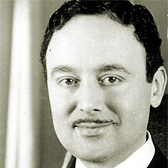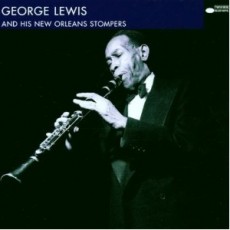
Daily Dose Of Jazz…
Peter DeRose was born on March 10, 1900 in New York City and as a boy exhibited a gift for music. His older sister taught him to play piano but composing was his true love and by 18 had published his first song. After high school he worked as a music store stock clerk but his successful 1920 composition “When You’re Gone, I Won’t Forget” led him to a job with Italian music publisher G. Ricordi & Company.
In 1923 he met his soon to be wife May Singhi Breen and the duet of piano and ukulele became popular entertainment on NBC’s musical radio show “Sweethearts of the Air” which ran for sixteen years. The show also offered a spotlight for DeRose to introduce many of his compositions.
Collaborating with lyricists Charles Tobias, Al Stillman, Carl Sigman and Billy Hill some of his best known works were “Somebody Loves Me”, Wagon Wheels, Rain, Lamp Is Low, On A Little Street In Singapore and Deep Purple. His songs have been performed by the likes of Bing Crosby, Paul Robeson, Ella Fitzgerald, Frank Sinatra, Johnny Mathis, Sarah Vaughan and Duke Ellington among others.
He wrote religious sheet music; composed for the 1941 Ice Capades show and ventured into Hollywood scoring music for several motion pictures. In 1970 he was inducted into the Songwriters Hall Of Fame.
The Hall of Fame composer of jazz and pop during the Tin Pan Alley era, composer Peter DeRose passed away on April 23, 1953 in his hometown of New York City.
More Posts: composer

Daily Dose Of Jazz…
Harlem was originally a wealthy white suburb of the New York City borough of Manhattan at the turn of the 20th century, but over-speculation led to a collapse of the housing boom and by 1904, fed by the Great Migration, thousands of Blacks began to reside in Harlem, taking advantage of inexpensive rents. By the 1920’s it became the major residential, cultural and business center for Black people. It was also the center of a flourishing entertainment business with black theaters and black artist performing for black audiences.
Originally a Dutch village formally organized in 1658 and named Haarlem after a Dutch town in the Netherlands and has been defined by a series of boom-or-bust cycles. Harlem was in vogue during the Roaring Twenties and the Harlem Renaissance and white socialites flocked north to hear Duke Ellington, Cab Calloway, Fats Waller, Chick Webb, Louis Armstrong and Bessie Smith. The premiere dance hall was the Savoy Ballroom with the big four clubs were The Cotton Club, Connie’s Inn, Small’s Paradise and Barron Wilkins, which was the first to open in 1915.
The Cotton Club, opened by gangster Owney Madden in 1922 moved downtown in ’36; Connie’s Inn opened in 1923 by George and Connie Immerman and Ed Smalls opened Small’s Paradise in 1925 and endured until 1986. All four catered to white audiences with lavishly staged shows featuring black performers such as James P. Johnson, Bill “ Bojangles” Robinson and Ethel Waters.
Swing and jazz were at its height and over the next several decades attracted the nightlife of both wealthy and working patrons to witness the greatest black musicians and performers in music and entertainment at a proliferation of theatres and clubs.
The most popular nightspots within the boundaries of the Hudson and East Rivers and from 100th to 155th Streets were the Alhambra Theatre, the Apollo Theatre, Bamboo Inn, Bamville Club, Band Box, Barron’s, Brittwood, Capitol Palace, Club Basha, Count Basie’s, Dickie Wells Shim Sham Club, Garden Of Joy, Golden Gate Ballroom, Harlem Club, Harlem Opera House, Heat Wave, Lafayette Theatre, Lenox Club, Leroy’s, Lido Ballroom, Lincoln Theatre, Luckey’s Rendezvous, Minton’s Playhouse, Monette’s Supper Club, Monroe’s Uptown House, Nest Club, Pod’s & Jerry’s, Renaissance Ballroom, Rendezvous Cabaret, Rhythm Club, Saratoga Club, Ubangi Club and Yeah Man.
Harlem, which has recently been given the name Manhattan North, has former President Bill Clinton to have a visible presence, has skyrocketed rental costs and townhouse sales , given much of 125th Street a makeover, attracting thousands of tourists and an influx of residents who at one time not too long ago would never have crossed Central Park North or come down into the valley from Columbia University.
More Posts: club,dance,history,instrumental,jazz,music,vocal

Daily Dose Of Jazz…
Ethel Waters was born in Chester, Pennsylvania on October 31, 1896 as a result of the rape of her teenaged mother, Louise Anderson by pianist and family acquaintance John Waters. Raised in poverty and never living in the same place for more than 15 months she had a difficult childhood.
Waters grew tall, standing 5’9½” in her teens, married at the age of 13, but soon left her abusive husband and became a maid in a Philadelphia hotel working for $4.75 per week. On her 17th birthday, she attended a costume party at a nightclub on Juniper Street and persuaded to sing two songs, she impressed the audience so much that she was offered professional work at the Lincoln Theatre in Baltimore, Maryland.
After Baltimore, Ethel toured on the black vaudeville circuit but success fell on hard times and she joined a carnival. Leaving that life in Chicago she headed to Atlanta, working the same clubs with Bessie Smith, singing ballads and popular songs instead of blues. But fame found her after her move to Harlem and its renaissance in the 1920s. She landed her first club gig in Harlem at Edmond’s Cellar, became an actress in the blackface comedy “Hello 1919”, and in 1921 became the fifth black woman to make a record, on the tiny Cardinal Records label. She later joined the Black Swan Record label where Fletcher Henderson was her accompanist.
She recorded for numerous labels over her career, played untold clubs and tours throughout the U.S. introducing standards like Dinah, Sweet Georgia Brown, Am I Blue and Black and Blue and worked with Duke Ellington. Film wooed her in 1933 with Rufus Jones for President featuring child star Sammy Davis Jr. in the title role. She went on to star at the Cotton Club singing Stormy Weather, had a featured role in the wildly successful Irving Berlin Broadway musical revue As Thousands Cheer in 1933, where she was the first black woman in an otherwise white show introducing Heat Wave and Supper Time to the world and was the highest paid performer on Broadway. In 1942 she starred in the Vincent Minnelli directed success Cabin In The Sky, reprising her 1940 stage role as Petunia.
Ethel Waters has three songs in the Grammy Hall of Fame, her version of Stormy Weather is on the Library of Congress’ National Recording Registry, was nominated for an Emmy for her performance in Route 66, was the second Black woman to be nominated for an Oscar for her role in Pinky, has a star approved but not funded on the Hollywood Walk of Fame, has written two autobiographies – His Eye is on the Sparrow and To Me, It’s Wonderful. The blues, jazz and gospel vocalist and actress passed away on September 1, 1977, aged 80, from uterine cancer, kidney failure, and other ailments in Chatsworth, California.
More Posts: vocal

Daily Dose Of Jazz…
George Lewis was born Joseph Louis Francois Zenon on July 13, 1900 in the French Quarter of New Orleans, Louisiana. Learning to play the clarinet he started his professional career by age 17, working with Buddy Petit and Chris Kelly regularly as well as the trombonist Kid Ory and other leaders.
It wasn’t until 1942 that George would gain recognition outside the city, when a group of New Orleans jazz enthusiasts, including jazz historian Bill Russell, went to record the older trumpeter Bunk Johnson who chose him as his clarinetist. Lewis was soon asked to make his first recordings as a leader for Russell’s American Music Records.
While working as a stevedore in 1944 a serious accident almost ended his music career however, while convalescing at home he improvised a blues that would become his signature “Burgundy Street Blues”. Lewis returned to play with Bunk Johnson until 1946, eventually taking leadership of the band after Bunk’s retirement.
Starting in 1949 Lewis had regular broadcasts from Bourbon Street on WDSU, was featured in Look Magazine in 1950 giving him international fame, began touring nationally and eventually to Europe and Japan. George Lewis, who achieved fame later in his life and who influenced the like of Louis Armstrong, played clarinet regularly at Preservation Hall from its opening in 1961 until shortly before his death on December 31, 1968.
More Posts: clarinet

Daily Dose Of Jazz…
Sam Wooding, born on June 17, 1895 in Philadelphia, Pennsylvania learned to play piano as a child, eventually becoming a bandleader who led several big bands in both the United States and abroad. In 1925 while performing at Small’s Paradise in Harlem, a Russian impresario hired him to be the pit band for the Chocolate Dandies in Berlin. That date led him to a record date for Vox Records with Doc Cheatham, Herb Fleming in the band.
In 1929, with a change in personnel, Wooding’s orchestra made more recordings in Barcelona and Paris for the Parlaphone and Pathé labels. He would remain in Europe, performing on the Continent, in Russia and England through most of the 1930s. He became an expatriate and his overseas stays made him virtually unknown in the States, building staunch jazz fans that liked what his orchestra offered.
Returning home in the late 1930s, when World War II seemed a certainty, Wooding began formal studies of music, attained a degree, and began teaching full-time, counting among his students trumpeter Clifford Brown. During this period he would lead and tour with the Southland Spiritual Choir. By the early 1970s, he formed another big band and took it to Switzerland for a successful concert, but this venture was short-lived. Pianist, arranger and bandleader Sam Wooding passed away on August 1, 1985 at age 89.
More Posts: piano




